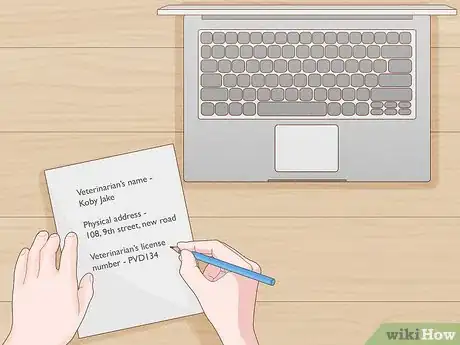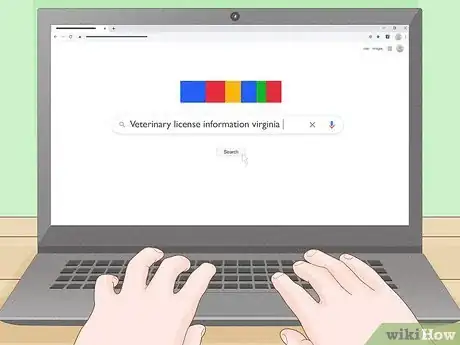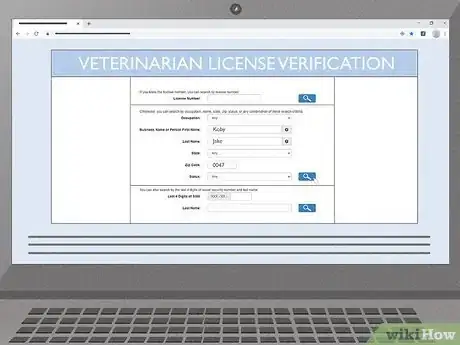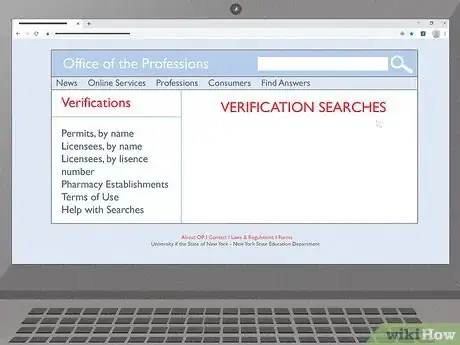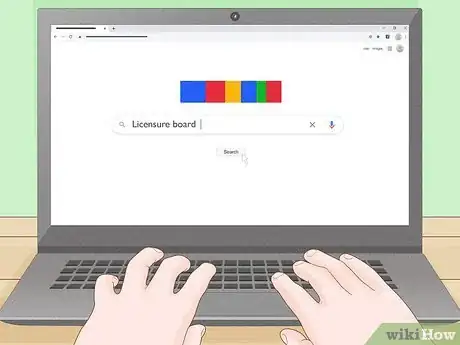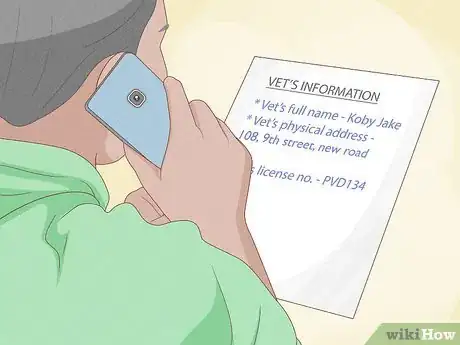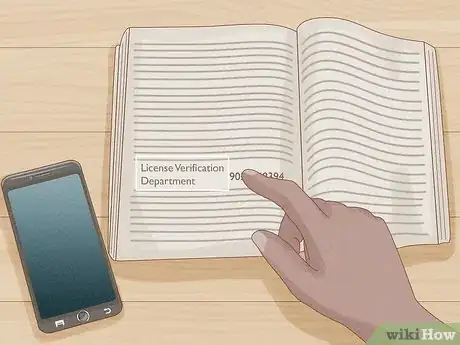This article was co-authored by Pippa Elliott, MRCVS. Dr. Elliott, BVMS, MRCVS is a veterinarian with over 30 years of experience in veterinary surgery and companion animal practice. She graduated from the University of Glasgow in 1987 with a degree in veterinary medicine and surgery. She has worked at the same animal clinic in her hometown for over 20 years.
This article has been viewed 33,172 times.
Choosing a veterinarian for your pet is an important decision. You want someone who you can trust, who is kind to your pet, and who is reputable and knowledgeable. However, finding a good licensed veterinarian can be difficult sometimes. One way to make it easier is to verify your potential veterinarian's license status. By checking their license information, you will be able to find out whether the veterinarian you are considering is currently licensed in your state. In addition, you'll find out whether that particular veterinarian has any disciplinary charges or actions against him or her.
Steps
Verifying a License Over the Internet
-
1Gather your veterinarian’s basic information. Most states have an online license verification system in which you can input basic data to verify a professional license. Depending on your state, you may need to gather different information. This is because state license verification systems are not standardized and information requirements vary from state to state. The most likely information will be:
- Your veterinarian’s full name.
- Your veterinarian’s physical address.
- Your veterinarian’s license number. In almost all cases, your veterinarian will post his or her license in a visible location in the lobby of their business.[1]
-
2Search for your state veterinary license board. In the United States, individual states are responsible for licensing and regulating veterinarians that practice within their borders. As a result, the first thing you need to do to verify a veterinary license over the internet is to search for your state veterinary license board.
- Each state’s website will vary. Often times, veterinary licensing boards will fall under the state department of business and/or professional regulation.
- The easiest way to find online verification for your state is to search for the term “verify veterinary license [state name here].” In most cases, one of the first results will link you to a verification page for your state.
- If searching for “verify veterinary license [state name here]” does not work, search for “veterinary license information [state name here].”
- If you still are having trouble finding your state’s license verification page, search for your state’s department of business regulation website. From there, search that website for veterinary license verification.[2]
Advertisement -
3Fill out the online search verification form. Once you’ve found your state’s online license verification system, you’ll need to fill out on the online search verification form.
- Use the information you gathered to populate the form.
- Make sure you have selected all of the appropriate boxes. Some forms may require you to select the licensure board in order to go ahead with the search. In this case, you’d search for a veterinary licensure board.
- Hit enter.[3]
-
4View the results and verify licensure. Once you’ve entered the required information and hit enter, the website will generate a list of licenses that match the information you’ve provided. From there, identify and verify your vet’s license.
- The website may show several licenses for the same person. Depending on the state, it may generate a veterinary license and a business license for your vet.
- Make sure that the veterinary license is “current.” It may also show “active.”
- If the license shows as “expired,” “suspended,” “in process,” or anything similar, your vet may be practicing illegally.[4]
Verifying a License by Phone
-
1Learn about the process of directly contacting licensure authorities. Since veterinarians are licensed by states in the United States, you’ll have to contact a state licensure board directly to verify an active license. By contacting the licensure board directly, you’ll be able to find out the status of your vet’s license and other relevant information.
- Many states have one department dedicated to business and professional regulation and licensure. This is the department you will probably contacting.
- In some cases, you will wind up speaking to someone directly at the veterinary licensure board for your state.
- Be prepared to be put on hold for a short or moderate amount of time.
-
2Collect the appropriate information. Make sure to get the appropriate information that you will need to identify your vet and verify a current veterinary license. Without the appropriate information, you won’t be able to supply the state licensure board with the information they will need to check the status of your vet’s license.
- Make sure to have your vet’s full name.
- Have your vet’s physical address on hand.
- If you can locate it, have your vet’s license number at hand. Very often, vets will post their license in the lobby of their practice.[5]
-
3Locate the phone number of the state licensure board or license verification department. You won't have to work too hard to find the phone number of your state’s licensure board. However, you’ll have to do a little work to get the number.
- Use your web browser or telephone directory to find the number for your state’s department of professional and business regulation.
- If you have trouble finding the direct number to the department of professional and business regulation, find a number for your state’s department of state. The department of state will be able to transfer you to the correct department or division.
- If someone offers to transfer you to the appropriate department, make sure to get the department’s direct number before being transferred. This way, if you get disconnected, you’ll be able to contact that department directly.[6] [7]
-
4Provide your vet’s information to the state worker on the phone. After you’ve finally made it through to someone in the correct department, provide your vet’s information. Soon after, the attendant should be able to provide the status of your vet’s license.
- The state representative will be able to explain exactly what the status of the license is.
- If you have any questions about the licensing process, ask the representative on the phone.
- If it turns out that your vet is practicing without a license, you should notify the state representative you are on the phone with.[8]
Warnings
- Report any veterinarian who is practicing without a license.⧼thumbs_response⧽
References
- ↑ http://www.op.nysed.gov/opsearches.htm
- ↑ http://www.op.nysed.gov/opsearches.htm
- ↑ http://www.op.nysed.gov/opsearches.htm
- ↑ https://license.ohio.gov/lookup/default.asp?division=88
- ↑ http://www.upmatters.com/news/local-news/check-the-license-of-michigan-professionals
- ↑ http://www.upmatters.com/news/local-news/check-the-license-of-michigan-professionals
- ↑ https://bovm.idaho.gov/license_search/
- ↑ https://bovm.idaho.gov/license_search/
About This Article
To check a veterinarian license, you'll need details of your vet's name, address, and license number, which should be displayed in their office or lobby. Then, search online for the license board in your state or area. Once you’ve found your local verification system, fill in the online form with your vet's details to get the result. Alternatively, if you'd prefer to confirm your vet’s license over the phone, you can find a number for your local license board on their website and call them instead. For more tips from our Veterinary co-author, including how to find a trusted vet in your area, read on!
